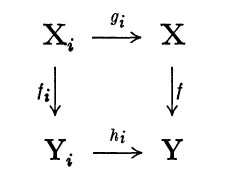The following results now have a complete proof in the stacks project:
- If F = U/R where R is an equivalence relation on U such that R —> U are flat and locally of finite presentation then F is an algebraic space.
- If F is a sheaf such that there exists U —> F which is representable by algebraic spaces, surjective, flat, and locally of finite presentation, then F is an algebraic space.
See Theorem Tag 04S6. This is the culmination of a lot of hard work and I am very happy that it is finally done!
The original reason for adding this to the stacks project was that I wanted to start writing about presentations of algebraic stacks. This immediately leads to the following two questions:
- Suppose that X is an algebraic stack with trivial inertia. Why is X an algebraic space?
- Suppose that (U, R, s, t, c) is a groupoid in algebraic spaces with s, t smooth. Why is the associated stack in groupoids [U/R] on (Sch/S)_{fppf} is an algebraic stack?
I would like to stress that both questions are nontrivial. Let me discuss why.
Part (a) is a bit easier if X is a Deligne-Mumford stack, see Lemma Tag 045H although it already uses a bootstrap argument for the diagonal. In the general case, besides bootstrapping the diagonal, you have to show that starting with a smooth equivalence relation you can get an etale equivalence relation with the same quotient sheaf. You can try to prove this by carefully slicing, which probably works, although it isn’t that easy (one problem is that you don’t know a priori which points to slice at even if everything is of finite type over a Noetherian base). Our approach is to see (a) as a direct consequence of (1) since after all a smooth morphism is flat and locally of finite presentation. Thus our proof of (a) completely takes one outside the realm of smooth presentations.
Part (b), besides a lot of general nonsense which already is documented in the stacks project, requires proving that the Isom sheaves of [U/R] are representable by algebraic spaces. This is relatively straightforward if you take the associated stack in the etale topology: you have to show a sheaf over a base scheme S which etale locally on S becomes an algebraic space is an algebraic space. But in the stacks project we use the fppf topology and it is not so straightforward: you have to show a sheaf over S which fppf locally on S becomes an algebraic space is an algebraic space. Although I haven’t written out all the details, I think this is a simple consequence of (2) above.
In the future we will need to discuss another theorem similar to the results above. Namely, Artin’s result that if (U, R, s, t, c) is a groupoid in algebraic spaces and s, t are flat and locally of finite presentation then the associated stack [U/R] is algebraic. The results above tell us that the only thing we need to do is show there exists a scheme and a surjective smooth morphism from that scheme onto [U/R], i.e., all the other properties have already been taken care of. To do this we will use Artin’s trick of looking at complete intersections in fibres of U —> [U/R]. But that will be another day!

